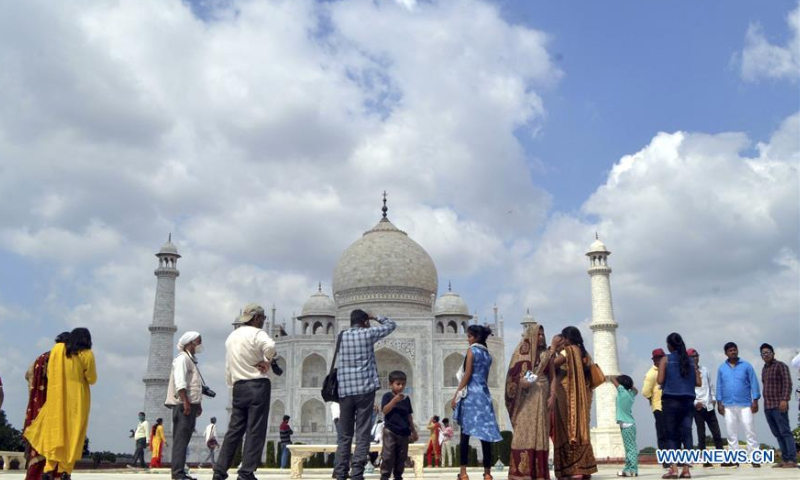IN-DEPTH / IN-DEPTH
90% of Chinese respondents want to learn more about India, hope to visit cities like Mumbai and New Delhi for tourism: GT survey

People visit the Taj Mahal in Agra, India, September 23, 2020. Photo: Xinhua
Chinese citizens show a strong willingness to learn more about India, with 90 percent expressing interest, and 64 percent expressing strong willingness, according to a recent survey by the Global Times. Mumbai and New Delhi are the top destinations for Chinese respondents, who also show interest in and familiarity with Indian films.
From May 23 to June 5, 2024, the Global Times Institute (GTI) conducted a survey in China and India, gathering opinions on India's role on the global stage, China-India relations, and India-US relations. In China, 1,440 valid samples were collected through online surveys. In India, 1,466 valid samples were collected through online surveys and face-to-face interviews, in four languages: English, Hindi, Tamil, and Bengali.
Nearly 70 percent (69 percent) of Chinese respondents hope to visit India in the future, a much higher percentage compared to Indian respondents' willingness to visit China.
Tourism (89 percent) is the primary reason for Chinese respondents to visit India, significantly higher than other reasons. Nearly 30 percent of respondents also hope to visit India for short-term business trips or visits.
The most desired Indian cities for Chinese respondents are Mumbai (56 percent) and New Delhi (51 percent), with nearly a quarter also interested in visiting Kolkata and Bangalore.
In comparison, nearly half (48 percent) of Indian respondents hope to visit China in the future. Indian respondents show a higher willingness to study, work, or immigrate to China. Beijing (51 percent) and Shanghai (49 percent) are the most desired Chinese cities for Indian respondents, with over 20 percent also wanting to visit Shenzhen.
More than half of the Chinese respondents have consumed Indian literature, films, or variety shows, and nearly 30 percent have purchased Indian products. Additionally, nearly 30 percent of Chinese respondents have limited knowledge and contact with India and Indian affairs.
Ninety percent of Chinese respondents have watched the Indian films listed in the survey, with over 40 percent having seen Dangal and 3 Idiots. More than 20 percent have watched Slumdog Millionaire and Devdas.
More than half of the Indian respondents have watched the Chinese films listed in the survey. The classic TV dramas Journey to the West (15 percent) and Romance of the Three Kingdoms (14 percent), both adapted from ancient literary works, have the highest viewership. Recently aired shows like Meet Yourself (10 percent) and Fry Me to the Moon (10 percent) also have relatively high viewership in India.
About half of the Indian respondents have purchased Chinese-made or Chinese-branded products; over 40 percent have used Chinese apps; and more than 30 percent have consumed Chinese literature, films, or variety shows.
The survey shows that in India, the most well-known Chinese brands are OPPO and VIVO, with awareness rates of 80 percent and 79 percent, respectively.
"This indicates that more Chinese people are gradually recognizing India's development and see India as an important force that may influence the global landscape in the future. They want to understand the real situation in India through more channels," Qian Feng, director of the research department at the National Strategy Institute at Tsinghua University, told the Global Times.
"To further improve bilateral relations, both sides can start with less sensitive areas, such as resuming direct flights, stationing journalists in both countries, easing visa restrictions, promoting tourism, think tank exchanges, study abroad programs, and dialogues. This would prevent the escalation of discord between the two nations," Qian noted.

